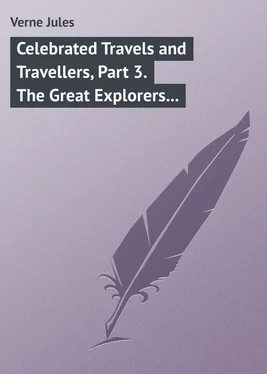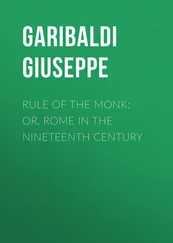Jules Verne - Celebrated Travels and Travellers, Part 3. The Great Explorers of the Nineteenth Century
Здесь есть возможность читать онлайн «Jules Verne - Celebrated Travels and Travellers, Part 3. The Great Explorers of the Nineteenth Century» — ознакомительный отрывок электронной книги совершенно бесплатно, а после прочтения отрывка купить полную версию. В некоторых случаях можно слушать аудио, скачать через торрент в формате fb2 и присутствует краткое содержание. Жанр: foreign_language, foreign_prose, на английском языке. Описание произведения, (предисловие) а так же отзывы посетителей доступны на портале библиотеки ЛибКат.
- Название:Celebrated Travels and Travellers, Part 3. The Great Explorers of the Nineteenth Century
- Автор:
- Жанр:
- Год:неизвестен
- ISBN:нет данных
- Рейтинг книги:5 / 5. Голосов: 1
-
Избранное:Добавить в избранное
- Отзывы:
-
Ваша оценка:
- 100
- 1
- 2
- 3
- 4
- 5
Celebrated Travels and Travellers, Part 3. The Great Explorers of the Nineteenth Century: краткое содержание, описание и аннотация
Предлагаем к чтению аннотацию, описание, краткое содержание или предисловие (зависит от того, что написал сам автор книги «Celebrated Travels and Travellers, Part 3. The Great Explorers of the Nineteenth Century»). Если вы не нашли необходимую информацию о книге — напишите в комментариях, мы постараемся отыскать её.
Celebrated Travels and Travellers, Part 3. The Great Explorers of the Nineteenth Century — читать онлайн ознакомительный отрывок
Ниже представлен текст книги, разбитый по страницам. Система сохранения места последней прочитанной страницы, позволяет с удобством читать онлайн бесплатно книгу «Celebrated Travels and Travellers, Part 3. The Great Explorers of the Nineteenth Century», без необходимости каждый раз заново искать на чём Вы остановились. Поставьте закладку, и сможете в любой момент перейти на страницу, на которой закончили чтение.
Интервал:
Закладка:
Burckhardt was a deeply learned man. He had passed through the universities of Leipzic, and Göttingen, where he attended Blumenbach's lectures, and afterwards through Cambridge, where he studied Arabic. He started for the East in 1809. To inure himself to the hardships of a traveller's life, he imposed long fasts upon himself, accustomed himself to endure thirst, and chose the pavements of London or dusty roads for a resting-place. But how trifling were these experiences in comparison with those involved in an apostolate of science!
Leaving London for Syria, where he hoped to perfect his knowledge of Arabic, Burckhardt intended to proceed to Cairo and to reach Fezzan by the route formerly opened up by Hornemann. Once arrived in that country, circumstances must determine his future course.
Burckhardt, having taken the name of Ibrahim-Ibn-Abdallah, intended to pass as an Indian Mussulman. In order to carry out this disguise, he had recourse to many expedients. In an obituary notice of him in the "Annales des Voyages," it is related that when unexpectedly called upon to speak the Indian language, he immediately had recourse to German. An Italian dragoman, suspecting him of being a giaour, pulled him by his beard, thereby offering him the greatest insult possible in his character of Mussulman. But Burckhardt had so thoroughly entered into the spirit of his rôle, that he responded by a vigorous blow, which sending the unfortunate dragoman spinning to a distance, turned the laugh against him, and thoroughly convinced the bystanders of the sincerity of the traveller.
Burckhardt remained at Aleppo from September, 1809, to February, 1812, pursuing his studies of Syrian manners and customs, and of the language of the country, with but one interruption, a six months' excursion to Damascus, Palmyra, and the Hauran, a country which had hitherto been visited by Seetzen only.
It is related that, during an excursion into Gor, a district north of Aleppo, upon the shores of the Euphrates, the traveller was robbed of his baggage and stripped of his clothes by a band of robbers. When nothing remained to him but his trousers, the wife of a chief, who had not received her share of the spoil, wished to relieve him even of those indispensable garments!
The Revue Germanique says: – "We owe a great deal of information to these excursions, respecting a country of which we had only crude notions, gained from Seetzen's incomplete communications. Burckhardt's power of close observation detected a number of interesting facts, even in well-known districts, which had escaped the notice of other travellers. These materials were published by Colonel Martin William Leake, himself a geographer, a man of learning, and a distinguished traveller."
Burckhardt had seen Palmyra and Baalbek, the slopes of Lebanon and the valley of the Orontes, Lake Huleh, and the sources of the Jordan; he had discovered many ancient sites; and his observations had led especially to the discovery of the site of the far-famed Apamoea, although both he and his publisher were mistaken in their application of the data obtained. His excursions in the Auranitis were equally rich, even though coming after Seetzen's, in those geographical and archæological details which represent the actual condition of a country, and throw a light upon the comparative geography of every age.
Leaving Damascus in 1813, Burckhardt visited the Dead Sea, the valley of Akâba, and the ancient port of Azcongater, districts which in our own day are traversed by parties of English, with their Murray , Cook , or Bædeker in their hands; but which then were only to be visited at the risk of life. In a lateral valley, the traveller came upon the ruins of Petra, the ancient capital of Arabia Petræa.
At the end of the year Burckhardt was at Cairo. Judging it best not to join the caravan which was just starting for Fezzan, he felt a great inclination to visit Nubia, a country rich in attractions for the historian, geographer, and archæologist. Nubia, the cradle of Egyptian civilization, had only been visited, since the days of the Portuguese Alvares, by Poncet and Lenoir Duroule, both Frenchmen, at the close of the seventeenth century, at the opening of the eighteenth by Bruce, whose narrative had so often been doubted, and by Norden, who had not penetrated beyond Derr.
In 1813 Burckhardt explored Nubia proper, including Mahass and Kemijour. This expedition cost him only forty-two francs, a very paltry sum in comparison with the price involved in the smallest attempt at an African journey in our own day; but we must not forget that Burckhardt was content to live upon millet-seed, and that his entire cortége consisted of two dromedaries.
Two Englishmen, Mr. Legh and Mr. Smelt, were travelling in the country at the same time, scattering gold and presents as they passed, and thus rendering the visits of their successors costly.
Burckhardt crossed the cataracts of the Nile. "A little farther on," says the narrative, "near a place called Djebel-Lamoule, the Arab guides practise a curious extortion." This is their plan of proceeding. They halt, descend from their camels, and arrange a little heap of sand and pebbles, in imitation of a Nubian tomb. This they, call " preparing the grave for the traveller " and follow up the demonstration by an imperious demand for money. Burckhardt having watched his guide commence this operation, began quietly to imitate him, and then said, "Here is thy grave; as we are brothers, it is but fair that we should be buried together." The Arab could not help laughing, both graves were simultaneously destroyed, and remounting the camels, the cavalcade proceeded, better friends than before. The Arab quoted a saying from the Koran: "No human being knows in what spot of the earth he will find his grave."
Burckhardt had hoped to get as far as Dingola, but was obliged to rest satisfied with collecting information about the country and the Mamelukes, who had taken refuge there after the massacre of their army by order of the viceroy of Egypt.
The attention of the traveller was frequently directed to the ruins of temples and ancient cities, than which none are more curious than those of Isambul.
"The temple on the banks of the Nile is approached by an avenue flanked by six colossal figures, which measure six feet and a half from the ground to the knees. They are representations of Isis and Osiris, in various attitudes. The sides and capitals of the pillars are covered with paintings or hieroglyphic carvings, in which Burckhardt thought a very ancient style was to be traced. All these are hewn out of the rock, and the faces appear to have been painted yellow, with black hair. Two hundred yards from this temple are the ruins of a still larger monument, consisting of four enormous figures, so deeply buried in the sand that it is impossible to say whether they are in a standing or sitting posture."
These descriptions of antiquities, which in our own day are accurately known by drawings and photographs, have, however, little value for us; and are merely interesting as indicating the state of the ruins when Burckhardt visited them, and enabling us to judge how far the depredations of the Arabs have since changed them.
Burckhardt's first excursion was limited to the borders of the Nile, a narrow space made up of little valleys, which debouched into the river. The traveller estimated the population of the country at 100,000, distributed over a surface of fertile land 450 miles in length, by a quarter of a mile in width.
"The men," says the narrative, "are, as a rule, muscular, rather shorter than the Egyptians, having little beard or moustache, usually merely a pointed beard under the chin. They have a pleasant expression, are superior to the Egyptians in courage and intelligence, and naturally inquisitive. They are not thieves. They occasionally pick up a fortune by dint of hard work, but they have little enterprise. Women share the same physical advantages, are pretty as a rule, and well made; their appearance is gentle and pleasing, and they are modest in behaviour. M. Denon has underrated the Nubians, but it must not be forgotten that their physique varies in different districts. Where there is much land to cultivate, they are well developed; but in districts where arable land is a mere strip, the people diminish in vigour, and are sometimes walking skeletons."
Читать дальшеИнтервал:
Закладка:
Похожие книги на «Celebrated Travels and Travellers, Part 3. The Great Explorers of the Nineteenth Century»
Представляем Вашему вниманию похожие книги на «Celebrated Travels and Travellers, Part 3. The Great Explorers of the Nineteenth Century» списком для выбора. Мы отобрали схожую по названию и смыслу литературу в надежде предоставить читателям больше вариантов отыскать новые, интересные, ещё непрочитанные произведения.
Обсуждение, отзывы о книге «Celebrated Travels and Travellers, Part 3. The Great Explorers of the Nineteenth Century» и просто собственные мнения читателей. Оставьте ваши комментарии, напишите, что Вы думаете о произведении, его смысле или главных героях. Укажите что конкретно понравилось, а что нет, и почему Вы так считаете.












